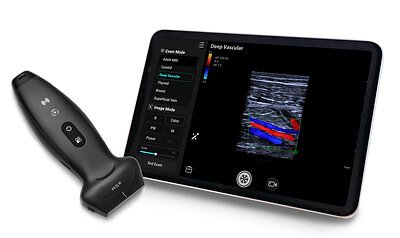
Portable Ultrasound Gains Traction: Mindray's New Device Disrupts Point-of-Care Imaging
Mindray’s TE Air e5M wireless handheld ultrasound aims to democratize medical imaging with its affordability and portability. This new device challenges established players in a rapidly expanding market.
Portable Ultrasound Gains Traction: Mindray's New Device Disrupts Point-of-Care Imaging
NEW YORK, NY – November 19, 2025
Expanding Access to Medical Imaging
Mindray North America has launched the TE Air e5M, a wireless handheld ultrasound device designed to broaden access to medical imaging across a range of care settings. The company’s newest addition to the TE Air series targets primary care, acute care, remote medicine, and educational environments, signaling a growing trend towards point-of-care ultrasound (POCUS) and portable diagnostic tools. While established players like GE Healthcare, Philips, and Butterfly Network have already staked claims in this space, Mindray is aiming to differentiate itself with a focus on affordability and a strategy that eliminates subscription fees.
“The demand for portable and accessible diagnostic tools is growing exponentially,” notes one industry analyst. “Healthcare providers are increasingly looking for ways to bring imaging capabilities directly to the patient, rather than relying solely on centralized radiology departments.” The TE Air e5M boasts whole-body scanning capability, 22 examination types, and up to 120 minutes of battery life. However, the device’s true potential lies in its ability to overcome barriers to access, particularly in underserved areas and resource-constrained settings.
The Rise of Point-of-Care Ultrasound
The market for portable ultrasound devices is experiencing significant growth, driven by several key factors. These include the increasing prevalence of chronic diseases, the aging population, and the need for faster and more efficient diagnostic procedures. POCUS allows healthcare providers to perform real-time imaging at the patient’s bedside, enabling quicker diagnoses, improved patient outcomes, and reduced healthcare costs. Emergency medicine, critical care, and rural healthcare are prime beneficiaries of this technology.
“POCUS has fundamentally changed how we approach patient assessment in the emergency department,” explains a physician specializing in emergency medicine. “It allows us to rapidly identify life-threatening conditions and make informed treatment decisions, often before traditional imaging studies are available.”
Mindray’s entrance into this market is particularly noteworthy, as the company is positioning the TE Air e5M as a cost-effective alternative to existing solutions. While competitors often rely on subscription models for software updates, extended warranties, and access to advanced features, Mindray has opted for a one-time purchase model with a standard three-year warranty and no ongoing subscription fees. This approach could appeal to budget-conscious healthcare providers and institutions.
A Competitive Landscape
The portable ultrasound market is becoming increasingly crowded, with several key players vying for market share. GE Healthcare’s Vscan Air and Philips Lumify are well-established solutions known for their image quality and versatility. Butterfly Network’s iQ+ utilizes a unique single-probe, whole-body imaging approach. Clarius offers a range of wireless handheld ultrasound scanners with varying levels of functionality.
“The competition in this space is fierce,” states one medical technology analyst. “Each company is trying to differentiate itself based on image quality, portability, functionality, and price. Mindray’s strategy of eliminating subscription fees is a bold move that could disrupt the market.”
While the image quality of the TE Air e5M is still being evaluated by independent reviewers, initial reports suggest that it is comparable to other leading handheld ultrasound devices. The device’s long battery life and wireless connectivity are also significant advantages. However, the device’s success will ultimately depend on its ability to meet the needs of healthcare providers and deliver a positive return on investment.
One physician specializing in remote healthcare noted, “For us, the total cost of ownership is critical. Subscription fees can quickly add up, making it difficult to justify the investment in new technology.” This sentiment highlights the appeal of Mindray’s pricing strategy, particularly for organizations operating on tight budgets.
Beyond the Hospital Walls
The applications for portable ultrasound extend far beyond the traditional hospital setting. Emergency medical services, disaster response teams, and even home healthcare providers are increasingly utilizing these devices to deliver care in a variety of challenging environments. The TE Air e5M’s compact size and wireless connectivity make it well-suited for these applications.
“In a disaster situation, time is of the essence,” explains a paramedic specializing in disaster response. “Having the ability to perform rapid assessments and diagnose injuries at the point of care can be life-saving.”
Furthermore, the TE Air e5M has the potential to improve access to healthcare in remote and underserved areas. By bringing imaging capabilities directly to the patient, healthcare providers can overcome barriers to access and deliver timely and effective care. The device could also be utilized for telehealth applications, allowing remote specialists to provide consultations and guidance to healthcare providers in the field.
As the market for portable ultrasound continues to grow, Mindray’s TE Air e5M is poised to become a significant player. With its focus on affordability, portability, and ease of use, the device has the potential to democratize medical imaging and improve access to care for patients around the world.
📝 This article is still being updated
Are you a relevant expert who could contribute your opinion or insights to this article? We'd love to hear from you. We will give you full credit for your contribution.
Contribute Your Expertise →